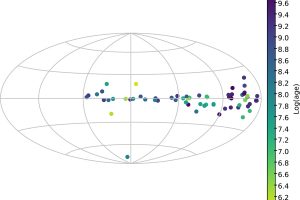A large catalog of stars associated with stellar clusters recently compiled in the framework of the Gaia-ESO Survey.

Star clusters are a product of the star formation process. During their gravitational collapse, in fact, molecular clouds fragment forming hundreds or even thousands of stars. During the first few tens of million of years of their evolution, the young stars formed in a cloud are bound by the intense mutual gravitational attraction, forming a stellar cluster. Star clusters are important astronomical objects for several reasons, such as:
- They are populated by rich samples of coeval stars covering a wide range of stellar masses, providing important samples for the study of stellar evolution;
- They trace the star formation in the Galaxy, and allow us to get important insight on its morphology and dynamics;
- They often host peculiar and rare stars, such as massive stars, pre-main sequence stars with protoplanetary discs, or magnetically active stars.
In the last years, the satellite of the European Space Agency Gaia has completely transformed our capability of identifying stars associated with stellar clusters. This thanks to its unmatched astrometric precisions and measurements of stellar proper motion (which is the component of the stellar motion projected on our sky), and the distance of stars from Earth. Stars associated with a given cluster, in fact, are at the same distance from us and they share a coherent proper motion. For several stellar components of the Milky Way, among which also star clusters, Gaia data were complemented with the Gaia-ESO Survey, led by S. Randich (INAF – OA Arcetri) and G. Gilmore (University of Cambridge). In the framework of this survey, more than 100000 stars were observed with the spectrograph FLAMES of the European Southern Observatory during 340 nights of observations in 7 years. These spectroscopic observations provide important data on the physical properties (such as spectral classes and chemical abundaces) and the evolutionary status of the observed stars, on the processes occurring in these stars (such as the accretion of gas from the protoplanetary discs), and on the component of stellar motion along the line of sight (the radial velocity).
To date, the Gaia-ESO Survey has provided the richest sample of spectroscopic observations of stars associated with star clusters. These observations in fact provide several reliable criteria useful to identify stars associated with stellar clusters. The paper: “The Gaia-ESO Survey: Target selection of open cluster stars” of A. Bragaglia (INAF – Astrophysics and Space Science Observatory of Bologna) describes the complicated work that allowed astronomers involved in the Gaia-ESO Survey to compile an extensive list of stars associated with stellar clusters. This work has been carried out by three working groups of the Gaia-ESO Survey: WG6 which was in charge of preparing the spectroscopic observations, WG4 who focussed on the selection of the observed stars, and WG1 in charge of the identification of stars associated with clusters. The final list counts 25100 stars associated with 64 clusters with an age ranging from about 1 million of years to 7 billion of years. To date, this is the most complete and rich list of stellar clusters members compiled from spectroscopic observations, a treasure chest for studies of the formation, evolution and dispersal of star clusters and stellar evolution. The research was published by Astronomy & Astrophysics. Among the coauthors, there are astronomers of the Gaia-ESO Consortium, among which E. Flaccomio, F. Damiani, L. Prisinzano and R. Bonito of INAF – Astronomical Observatory of Palermo.
The figure (click here to visualize the entire image), shows the spatial distribution of the star clusters included in the Gaia-ESO Survey in galactic coordinates. In this coordinate frame, the Galactic plane corresponds to the central vertical line.
